#Nasa In Memoriam
Explore tagged Tumblr posts
Text
Sally Ride Norman Rockwell style

0 notes
Text
#notable deaths#obituaries#deaths (obituaries)#in memoriam#obituary#nasa#earthrise#photography#astronauts#apollo 8
0 notes
Text
In Memoriam: Dr. Richard S. Stolarski [19412024]
Renowned ozone scientist Dr. Richard “Rich” Stolarski died on February 22, 2024, at age 82 from the complications of prostate cancer. Rich was born at Fort Lewis, WA on November 22, 1941. After short stays in Kansas and Hawaii, Rich’s family settled in Tacoma, WA. He attended Stadium High School for three years and Wilson […] from NASA https://ift.tt/zXoFb4i
0 notes
Text
EVENT - PRIMAVERA FT. NAOMI SCOTT, 88, MISSY ELLIOTT

the vibe of the video reflects Burke's aesthetic if nothing to one (sex appeal: what Demi Lovato missed out (Lalaland map)
Burke is host Fallon's appeal (no sex)
makes the band with the extra look good
no men in the video to seduce appeal for the viewer (self-gratification)

no appeal to lighting (referencing Not Giving Up - The Saturdays)

the general f*cking vibe

wonder p*rn (what boys get hot shit about)


Bratz in black minicxiii 2010 energy of a 2020's thot whore blonde powerhouse juice mixer (catalina wine mistress)


she is literally God in gold like that switch-up (even Allah calls her his side-wife) like i don't even see until she's there (mashaa allah)


strippers red. on desi skin. will kill. i don't have sabr. i have possession of a scorpio mars. stilletto's. step on me. freak. daddy's gold. mother's gem. bastard. fuck me. 5:00 am. pornography gone homo. homeless.


sex on ice. red lion. Whip from KOF. armegeddon. Lancelot. cock me hard. dynasty. broken lion. wonder woman. dick after 9. one ten 9. silver rocks. creamy. evangellion. elysium on a hard stone licking desi mirrors the same way again, miss red lip ruby woo 99 sock fucker


she eats big d***. ass robbery and she 8 it. one last look and her skinny bitch witch friends made her famous for it. McDonalds for 7 days a week, she 8 it. Blonde fat bitch on Get Smart flipped the bird iconic she ate it. Adam Scott on weekdays made it. made Linna type her way into Starr's bed rated it. 9/10 (he into fat women now) elevated it. skies aren't blue anymore, they're fat (Kierkegaard's Homelander once said 'aged it')

sex on the streets energy (same outfit) he can't even see (the main character vibe of KOF is sexually absent to 15yo girls rn on Tindr (as they should be)


same outfit (main event (woman to be wedded: same happens to alternate visions (versions) when the time comes) Linna in wet naked nazar (silver lady from a videogame (KOF) played you (Whip) waiting for you in the same dress turning up as your wildest dreams (to be played with (high intellect meets high emotional capacity)

right use at the right day to justify elevation on a car (fast like his ability to believe you by chance (Omni-man)

self-centred desi on the role to man hunt (red is more elevated on her honour on the band's role to elevate the colour itself being expiated for capitalism affairs around your own home (disaster bastard heartbreak)


perrie dripping on the edge of freedom (making the desi woman happier) she sluts off but it does not count cuz she likes drippy shit for a living

glitter version of heart attack (demi lovato)

Primavera presents: featuring - Naomi Scott spam

whatever Evangeline Lilly did (Linna looks like her) in a cycle of events looking like the fucking franchise itself (even Peter Jackson (ra) wants to direct (mashaa allah on him (do that for Perrie's engagement sometime soon (end the blonde bimbo dramas for South Park dialogue to free air (you knew)

why women can't get married: Jesy Nelson degrades.

you walk away, drive a Honda (broke af memoriam for the new driver (you should not be into gays)

my phone case in the past has a point and it will curse you (whatever Rupaul is thinking rn: tech-lords in NASA is the rappers guild figuring a vagina looking like Rachel Berry's Neon Lights (nazar-break)

forgotten member of the band has a point (vocal adrenaline)

Linna is dripping red dick rn (your move, Kierkegaard)

Linna making a fetish look good for married women to divorce (standards making conceptions making progress: the phat man can eat himself to death, no wonder desi women love the band cuz of one dumb blonde and a roti being best friends for a disabled now sexless wap over you woman looking for
1 note
·
View note
Link
Earth Observer Earth Home Earth Observer Home Editor’s Corner Feature Articles Meeting Summaries News Science in the News Calendars In Memoriam More Archives 9 min read Looking Back on Looking Up: The 2024 Total Solar Eclipse Credit: NASA’s Glenn Research Center (GRC) Introduction First as a bite, then a half Moon, until crescent-shaped shadows dance through the leaves and the temperature begins to drop – a total solar eclipse can be felt growing in the atmosphere. As the sky darkens in the few minutes before totality, the sounds of animals begin to dissipate along with the vibrancy of red and orange hues, and we enter the mesopic zone, or twilight vision. All is quiet in these cold, silvery-blue moments, until the Moon lines up perfectly with the Sun from our viewpoint on Earth – an odd quirk of the Moon–Earth system, and an occurrence that does not exist elsewhere in the solar system. Millions of people gazed up at the sky on April 8, 2024, as a total solar eclipse darkened the skies across a thin ribbon of North America – spanning Mexico’s Pacific coast to the Atlantic coast of Newfoundland, Canada – see Figure 1. Figure 1. A total solar eclipse was visible along a narrow track stretching from Texas to Maine on April 8, 2024. A partial eclipse was visible throughout all 48 contiguous U.S. states. Figure credit: NASA Scientific Visualization Studio A pearly, iridescent halo lined the perimeter of the Moon as it crossed in front of the Sun, revealing the Sun’s corona – see Photo 1. Solar prominences – bright features made of plasma flowing outwards through tangled structures of magnetic fields along the Sun’s surface – were observable as reddish-pink dots rising from the edges of the eclipsed Sun – see Photo 2. Photo 1. The moment of totality in Cleveland, OH. Photo credit: NASA’s Glenn Research Center (GRC) Photo 2. Solar prominence [lower right of the solar disc] seen during totality in Cleveland, OH. Photo credit: GRC Snapshots of NASA Science Outreach Along the Path of Totality Over 400 NASA staff took up positions along the path of totality, hosting various events to engage the public in outreach activities spanning the scope of NASA Science. NASA staff hosted 14 “SunSpot” locations across 7 states (Texas, Arkansas, Ohio, Indiana, Pennsylvania, New York, and Maine), including 224 NASA engagement and Science Activation events. As an example, Zoe Jenkins [NASA Headquarters/Arctic Slope Regional Corporation (ASRC) Federal—Graphic Designer] was stationed in Maine to view the eclipse –see Photos 3–4. More information about events at these SunSpots is available at the eclipse website. The Science Activation Program furthered NASA’s message, reaching all 50 states through public events by sharing information and providing professional development programming for educators. (To learn more about NASA’s Science Activation Program, see NASA Earth Science and Education Update: Introducing the Science Activation Program, The Earth Observer, 35:6, 6–12.) Photo 3. NASA Eclipse celebration at the SunSpot in Houlton, ME. Photo credit: Zoe Jenkins/NASA Headquarters (HQ)/Arctic Slope Regional Corporation (ASRC) Federal Photo 4. View of the black hole of the Moon’s shadow over the Sun during totality in Houlton, ME. Photo credit: Zoe Jenkins Among the SunSpot locations across the path of totality, NASA’s Science Support Office (SSO) staffed events at two of them: in Cleveland, OH and Kerrville, TX. The Great Lakes Science Center and its two partners – NASA’s Glenn Research Center (GRC) and the Cleveland Orchestra – presented “Total Eclipse Fest 2024,” a three-day celestial celebration at North Coast Harbor in downtown Cleveland beginning April 6 and culminating on the day of the eclipse. The event included free concerts, performances, speakers, and hands-on science activities. At the heart of the festival was the “NASA Village,” an immersive experience featuring the agency’s major missions and projects aimed at advancing space exploration and revolutionizing air travel. Figure 2 shows the location of each outreach tent in the village, while Figure 3 provides descriptions of each activity. More than 36,000 attendees visited the NASA village over the three-day event. Exhibits focused on innovations in aeronautics, space, solar, and lunar science, and best practices for ensuring a safe solar eclipse viewing experience. Through virtual and augmented simulations, attendees had the opportunity to take a supersonic flight, walk on Mars, and visit the International Space Station. Attendees of all ages participated in hands-on activities and talked to NASA scientists and engineers about their work and how to join the NASA team. Attendees could also walk through Journey to Tomorrow, a traveling exhibit complete with interactive English and Spanish-language content, and see an Apollo-era Moon rock. Visitors also explored large-scale, inflatable displays of the X-59 plane designed to quiet supersonic air travel, the Space Launch System rocket slated to take the first woman and person of color to the Moon, and a Mars habitat concept. Throughout the NASA Village, attendees could take advantage of several photo opportunities, including iconic NASA cutouts and displays. NASA also hosted astronaut autograph signing sessions, as well as special guest “meet and greets.” Figure 2. Map of the “NASA Village” at the Eclipse festival in Cleveland, OH, hosted by GRC. See Figure 3 for activity descriptions. Figure credit: GRC Figure 3. Descriptions of each outreach activity stationed at individual tents within the NASA Village over the three-day festival. See Figure 2 for map. Figure credit: GRC A View of the Eclipse from Cleveland In Cleveland, the eclipse began at 1:59 PM EDT, with totality spanning 3:13–3:17 PM. The eclipse concluded at 4:28 PM. SSO staff supported total eclipse outreach from April 5–9, specifically engaging attendees at the Solar Science tent within the NASA Village and providing information about eclipse safety and heliophysics, and handing out items such as the NASA Science calendar, NASA tote bags, and other outreach materials. SSO also supported a NASA photo booth with eclipse-themed props and took hundreds of souvenir photos for visitors to remember their time at the festival – see Photos 5–9. Photo 5. SSO staff member Dalia Kirshenblat [NASA’s Goddard Space Flight Center (GSFC)/Global Science and Technology Inc.(GST)] handed out NASA Science calendars, eclipse glasses, posters, and other NASA outreach materials. The materials informed attendees about eclipse viewing safety and shared NASA science, engaging in topics that explained how eclipses occur. Photo credit: GRC Photo 6. Jack Kaye [NASA HQ—Associate Director for Research, Earth Science Division (ESD)] hands out eclipse posters and other outreach materials to attendees at Eclipse Fest 2024. Photo credit: GRC Photo 7. Steve Graham [GSFC/GST], Dalia Kirshenblat, and Danielle Kirshenblat [Space Telescope Science Institute (STScI)] pose with NASA SSO photo booth props at Eclipse Fest 2024. SSO staff took hundreds of pictures of visitors with the photo booth props as keepsakes. Photo credit: NASA Photo 8. Dalia Kirshenblat and Danielle Kirshenblat watching the eclipse begin in Cleveland, OH, at approximately 2:00 PM EDT. Photo credit: NASA Photo 9. Steve Graham, Dalia Kirshenblat, Danielle Kirshenblat, and other Eclipse Fest attendees gaze at the celestial show unfolding above them as totality begins in Cleveland, OH, at approximately 3:13 PM EDT. Photo credit: Danielle Kirshenblat Eclipse Engagement in Texas In addition to the Cleveland eclipse festival, SSO staff members supported total eclipse engagement in Kerrville, TX, from April 5–9, including several small events at Cailloux Theatre, Doyle Community Center, Trailhead Garden, and Kerrville-Schreiner Park leading up to the eclipse. (While a bit more remote than Cleveland, Kerville was chosen as a SunSpot location during the total eclipse because it was also in the path of the October 2023 annular eclipse, NASA had outreach activities in Kerville for that eclipse as well). The events culminated on April 8 at Louise Hays Park. NASA’s impact on the community was wide-reaching, engaging approximately 4000 individual interactions with community members and visitors. The feedback was overwhelmingly positive and appreciative. On April 8, SSO provided astronaut handler support for NASA Astronaut Reid Wiseman – who will command the Artemis II Moon mission – during a “photos with an astronaut” session. SSO staff also escorted Wiseman to and from a main stage speaking engagement and the NASA broadcast engagement – see Photos 10–13. Photo 10. Ellen Gray [GSFC/KBR—Senior Outreach Specialist] engaging attendees in Kerrville, TX with various NASA Science outreach materials. Photo credit: NASA Photo 11. NASA Astronaut Reid Wiseman poses with a potential future astronaut and attendee at the Eclipse event in Kerrville, TX. Photo credit: NASA Photo 12. Astronaut Reid Wiseman speaks at a NASA broadcast in Kerrville, TX. Photo credit: NASA Photo 13. [left to right] Nicola Fox [NASA HQ—Associate Administrator for the Science Mission Directorate (SMD)], Alex Lockwood [NASA HQ—Strategic Engagement Lead], and Astronaut Reid Wiseman. Photo credit: NASA NASA Science Engagement Across the Agency As millions gazed at totality from the ground, NASA was conducting science from the skies. Atmospheric Perturbations around the Eclipse Path (APEP), a NASA sounding rocket mission, launched three rockets from NASA’s Wallops Flight Facility in Virginia to study how the sudden dip in sunlight that occurs during an eclipse affects the upper atmosphere. Each rocket deployed four scientific instruments that measured changes in electric and magnetic fields, density, and temperature – see Photo 14. Photo 14. The Atmospheric Perturbations launched around the Eclipse Period (APEP) sounding rocket during the total eclipse on April. This photo shows the third APEP sounding rocket – launched during the October 2023 annular eclipse – leaving the launchpad. Photo credit: WSMR Army Photo As part of the Nationwide Eclipse Ballooning Project, student teams constructed hundreds of balloons and launched them during the eclipse, encouraging students to consider careers in the STEM workforce. Also, two WB-57 aircraft carried instruments to further extend scientific observations made during the eclipse. By taking images above Earth’s atmosphere, scientists were able to see new details of structures in the middle and lower corona. The observations – taken with a camera that images in infrared and visible light at high resolution and high speed – could improve our understanding of the dust ring around the Sun and help search for asteroids that may orbit near the Sun. The WB-57 flights also carried instruments to learn more about the temperature and chemical composition of the corona and coronal mass ejections – or large bursts of solar material. By flying these instruments on a WB-57, the scientists extended their time in the Moon’s shadow by over two minutes from what could be achieved using ground-based observations. A third experiment used an ionosonde to study the ionosphere – the charged layer of Earth’s upper atmosphere. The device functions like a simple radar, sending out high frequency radio signals and listening for their echo rebounding off the ionosphere. The echoes allow researchers to measure how the ionosphere’s charge changed during the eclipse – see Photo 15. Photo 15. Pilots prepare for the 2024 total solar eclipse experiments on the NASA WB-57 aircraft on April 8, 2024 at Ellington Field in Houston, TX. Photo credit: NASA/James Blair The eclipse also provided an opportunity for the public to contribute to the NASA Citizen Science program – a project called Eclipse Soundscapes reached over 900 people during their training programs to prepare for the eclipse. Over 36,000 individual citizen scientists contributed more than 60,000 data submissions across the eclipse path, recording the reactions of wildlife before, during, and after this celestial event. As part of NASA’s Heliophysics Big Year to celebrate the Sun, NASA played a key role in enabling safe participation as well as working with new-to-NASA audiences. NASA’s Science Mission Directorate ordered and distributed 2.05 million eclipse glasses across the country, with distribution locations including K–12 schools, libraries, minority-serving institutions, community events, museums, partner organizations, underserved communities, science centers, and NASA personnel. As of April 8, Science Activation reached over 2000 educators across the country through programming designed to prepare educators for the eclipse and provide them with educational resources to train students in STEM. NASA broadcasted a livestream of engagement events on NASA+, the NASA App, NASA.gov, and NASA social media channels. By 4:30 PM EDT, NASA’s websites spiked (e.g., nasa.gov, science.nasa.gov, plus.nasa.gov, and ciencia.nasa.gov) with nearly 28.9 million views and 15.6 million unique visitors. At its peak, 1,458,212 people watched the eclipse broadcast live, experiencing the eclipse together through the eyes of NASA. Total viewership as of 4:30 PM EDT was 13,511,924. NASA’s Office of Communications Engagement Division organized at least 17 in-person and digital partner interactions, including several Major League Baseball games, Google eclipse safety Doodle and search effect, coverage of NASA on NASDAQ’s screen in Times Square, a solar songs request weekend on Third Rock Radio, and a Snoopy visit to the Cleveland sunspot. Several partners also interacted on social media, including Barbie, Cookie Monster, Elmo, Snoopy, LEGO, and other partner accounts. Conclusion The 2024 total eclipse brought joy and awe to millions, inspiring so many to look up, be curious about the natural world around them, and explore the sky. The next total solar eclipse will occur in 2026 and will be visible in Spain, a small area of Portugal, as well as Iceland, Greenland, and Russia. We won’t see another total eclipse in the U.S. until 2044. To view this video please enable JavaScript, and consider upgrading to a web browser that supports HTML5 video Movie. Timelapse of the eclipse’s totality in Cleveland, OH. Video credit: Danielle Kirshenblat Dalia Kirshenblat NASA’s Goddard Space Flight Center/Global Science and Technology, [email protected] Share Details Last Updated Aug 22, 2024 Related Terms Earth Science
0 notes
Text
In Memoriam: Dr. Ed Stone, Former NASA JPL Director and Voyager Project Scientist
http://i.securitythinkingcap.com/T8M4YX
0 notes
Text
youtube
Arvo Pärt, Cantus in memoriam Benjamin Britten
Jan 3, 2010
Arvo Pärt, Cantus in memoriam Benjamin Britten,
Strings of Hungarian State Opera, Tamas Benedek, conductor, Antal Eisrich, percussion. A special thanks to NASA and the Hubbel Showcase.
438 Comments
1 note
·
View note
Text

Relatives and supporters of Alexei Navalny bid farewell to the opposition leader at a funeral, following a battle with authorities over the release of his body after his still-unexplained death.
(Photo: Associated Press)

People crowded around the hearse transporting Alexei Navalny's body in Moscow.
(Photo: Reuters - Stringer)

People knock down barriers while leaving an area outside the Soothe My Sorrows church.
(Photo: Reuters - Stringer)

Workers carry the coffin and a portrait of Russian opposition leader Alexei Navalny out of the church. (Photo: Associated Press)

Alexei Navalny's parents Anatoly Navalny (right), and Lyudmila Navalnaya, arrive at the church on Friday. (Photo: Associated Press)

Australia's ambassador John Geering lays flowers near Alexei Navalny's grave.
(Photo: X/Twitter - @PosolAustralia)

Foreign diplomats, including French Ambassador to Russia Pierre Levy and US Ambassador to Russia Lynne Tracy attended the service.
(Photo Reuters: Stringer)
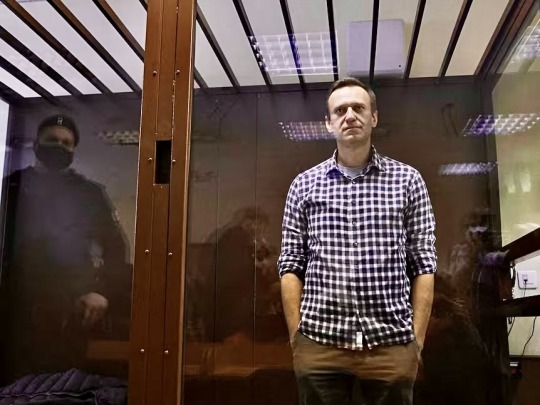
Russian opposition leader Alexei Navalny attends a court hearing in Moscow in 2021.
(Photo: Reuters - Maxim Shemetov)
'Putin is a murderer’: Australia's ambassador among mourners as Navalny's funeral becomes rare protest
Australia's ambassador to Russia was among a rare public anti-Kremlin demonstration when he joined a large crowd at the funeral of opposition leader Alexei Navalny in Moscow on Friday.
John Geering, who began his posting in November, and other Western diplomats were at the service with thousands of mourners and supporters in the district of Maryino, despite warnings from Russian authorities that people could be arrested.
The throng chanted "we are not afraid", "Putin is a murderer", "no war" and "Russia will be free", as the 47-year-old's body was carried into The Church of the Icon of the Mother of God Soothe My Sorrows.
Mr Geering said when he and the other Western diplomats attempted to enter the church, police stopped them.
He later released a statement saying he had been "profoundly impacted and moved by the depth of grief shown by many thousands today at the funeral of Alexei Navalny. Those remembering his legacy at the funeral carry on his hopes for a better Russia. Australia and the world shares your grief and your hopes".
By Riley Stuart in London
ABC News - March 2, 2024
•
•
YouTube video >> Anne Akiko Meyers performs Arvo Pärt's "Fratres" with the Tallinn Chamber Orchestra, Kaljuste - Arvo Pärt Centre [Released: 9 December 2018 / 11mins.+48secs.]:
youtube
In memory of Alexei Navalny RIP
Sic transit gloria mundi
•
•
YouTube video >> Arvo Pärt, Cantus in memoriam Benjamin Britten with the Hungarian State Opera, Tamas Benedek, conductor, Antal Eisrich, percussion [Released: 3 January 2010 / 7mins.+46secs.]:
Arvo Pärt, Cantus in memoriam Benjamin Britten
youtube
Arvo Pärt, Cantus in memoriam Benjamin Britten, Strings of Hungarian State Opera, Tamas Benedek, conductor, Antal Eisrich, percussion. A special thanks to NASA and the Hubbel Showcase.
In memory of Alexei Navalny RIP
Sic transit gloria mundi
•
1 note
·
View note
Photo

Kolarac 28. juna u 18 u Kinoteci predstavlja Aleksandra Simića kao rezidentnog kompozitora
Tangenta
Programom pod nazivom koji sugeriše izletanje iz začaranih krugova svakodnevice, Kolarčeva zadužbina će u sredu, 28. juna u 18 časova u Velikoj sali Jugoslovenske kinoteke predstaviti internacionalno afirmisanog umetnika Aleksandra Simića kao svog "kompozitora u rezidenciji". Veliki deo Simićevog opusa koji broji preko stotinu kompozicija za različite ansamble, od kamernih do simfonijskih, nastao je kroz period od oko tri decenije u saradnji sa institucijama poput Ujedinjenih Nacija, Vatikana, NASA, Stejt Dipartmenta, Ruske Federacije i Jad Vašema, i veoma često sa idejom stavljanja umetnosti u službu promocije mira, empatije i odgovornosti prema fizičkom i vremenskom prostoru koji delimo, redovno nesvesni potrebe da harmonizujemo različite pojedinačne interese nacija, religija i kultura.
Jedna od tangenti programa zakazanog za 28. jun jeste i izletanje iz prostora Kolarčeve zadužbine i saradnja sa komšijskom i sestrinskom institucijom kao što je Kinoteka. Publika će tokom razgovora sa Simićem, koji će ovom prilikom voditi novinar, esejista i književnik Muharem Bazdulj, imati priliku i da na bioskopskom platnu uživa u projekcijama odlomaka iz Simićevih dela kao što su In Memoriam, Under One Roof (Pod istim krovom), Missa Solemnior i Grad u kome je stalo vreme.
Prisutni će takođe moći da se upoznaju sa idejama vezanim za ovu rezidenciju, a koje uključuju saradnju sa različitim umetnicima iz sveta muzike, književnosti, filma, baleta, a i nekim projektima vezanim za saradnju sa institucijama civilnog društva i onim koji će biti pre svega humanitarnog karaktera s obzirom na to da je Simić široj javnosti, osim po muzici, poznat i po predanom društvenom angažmanu. "Nova i agilna uprava KNU, na čelu sa g. Aleksandrom Pekovićem, koja se u proteklih godinu dana trudi da ovoj važnoj instituciji obezbedi uslove za jednu novu fazu njenog života i delovanja, veruje da Kolarac kao svojevrsni Genius Loci kulture glavnog grada ima jedinstven zadatak negovanja i podmlađivanja duha njegovih žitelja, i zato zajedno obećavamo da će ovo zdanje na Studentskom trgu broj 5 biti i ostati adresa sa koje dolaze i na koju stižu najvažnije vesti iz domena kulture, obrazovanja i umetnosti", ističe, komentarišući svoje postavljenje, kompozitor Simić.
Foto: Mika Knežević
#kolarac#kultura#aleksandar simic#kompozitor#kolarčeva zadužbina#tangenta#muharem bazdulj#umetnost#mir#empatija#sigurnost#kinoteka#ideje
0 notes
Text
Sally Ride age progression in Norman Rockwell style ultra hyper Realism

1 note
·
View note
Text

"In Memoriam Clive Temperton": April Poem #7 Tem was one of my dearest friends since Beverley Grammar School days, and the Best Man at our wedding. He was also was a world-renowned meteorologist/computational scientist who developed the systems we currently use for weather forecasting. He worked for the Met-Office and the European Centre for medium-range weather forecasting, as well as for the Canadian government and in collaboration with NASA.
In Memoriam Clive Temperton (1946-2022)
Legendary mathematician and meteorologist
Amaze them, Tem!
Subdue the roaring forties
with mathematics.
Snare rain, pressure systems
anticyclogenesis
in data sets that run
to thousands, millions.
Forecast at speed –
no one wants yesterday’s weather.
Render the rain that wets your face
and the ab-polar currents that transport it
into Fast Fourier Transforms,
calculate, programme, make the concrete abstract
and then turn it back again to sunshine.
And in the evening, write me
those long brilliant letters,
so wickedly funny and humble that
I can still recite parts of them off by heart.
Each morning, half way up the hill to school,
I would hold your Claude Butler bike
as you ran down the allotment path
to check the brassy rain gauge,
notebook in hand.
I wish I’d been able to say, as you stuck
the biro back in your blazer pocket
“One day, Tem,
you’ll be a legend at the ECMWF.”
And when you raised an eyebrow, add
“The European Weather Centre, of course!”
0 notes
Photo


Saying goodbye to Opportunity …
#display windows#bookstores#science#science fiction#space#Opportunity Rover#Mars#space exploration#in memoriam#indies#bookish#book photography#NASA
7 notes
·
View notes
Text
Bidding farewell to an unsung legend

R.I.P. James A. McDivitt, test pilot and astronaut. He passed away on October 13 and somehow it flew utterly beneath my radar.
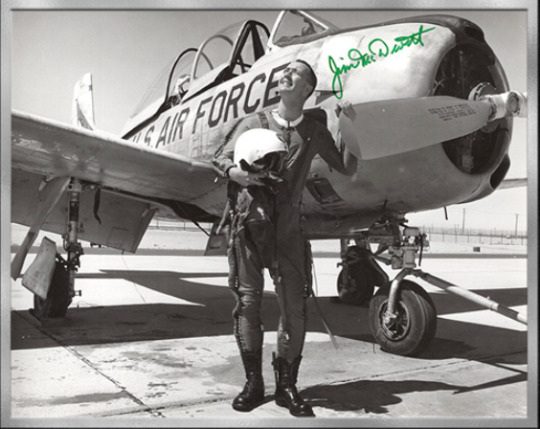
Jim McDivitt was a Korean War combat pilot, and earned a Bachelors in Aeronautical Engineering from University of Michigan, a spot in the USAF Experimental Flight Test Pilot School, and was a member of the inaugural class at the Aerospace Research Pilot School. He had over 2,000 hours in jets (here he is striking a heroic pose with a decidedly not-heroic T-28).
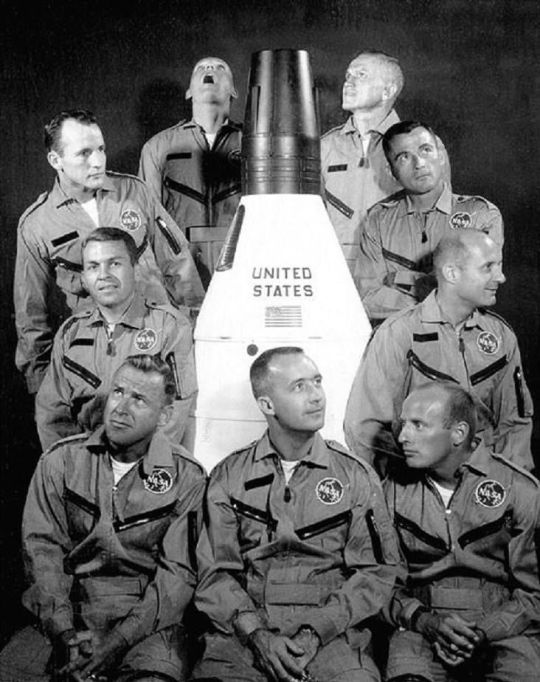
Later Jim was selected as a member of NASA Group 2, known as “the New (or Next) Nine.” They were chosen to augment the Original Seven for the Gemini program and beyond. From lower left, they are Jim Lovell*, Elliot See, Ed White, Neil Armstrong**, Frank Borman*, John Young**, Tom Stafford*, Pete Conrad**, and that's Jim McDivitt front and center.
(*) Six of this group went to the Moon and three (**) of them walked on it; two more died in tragic accidents before getting their chance to go. None of them were Jim McDivitt, so his career is often overlooked.

Thanks to a thing called “the pecking order,” the Mercury Seven were automatically first in line when it came to getting the mission assignments, but with the two-man Gemini program starting up, that meant Chief Astronaut Deke Slayton could assign some of these new guys to fill the right seat while the Mercury veterans commanded the mission. John Young was the first guy from Group 2 to fly, paired with America's second man in space Gus Grissom, for the first crewed Gemini mission: a simple (well, as simple as anything related to spaceflight can be, that is) shakedown flight called Gemini 3.
But Gemini 4 (June 1965) was much more ambitious, and McDivitt was given command, making him the first rookie to command a crew.
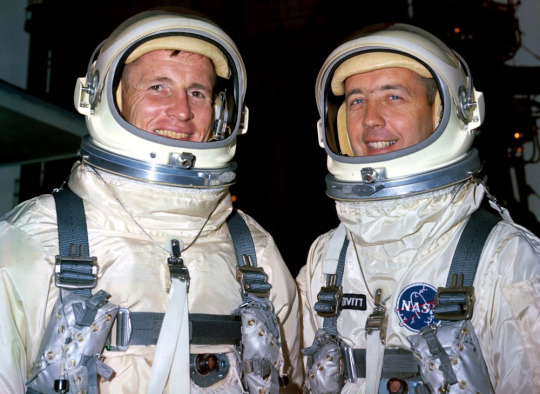
Flying right seat (left, in this photo) was his fellow Group 2 buddy and former University of Michigan schoolmate Ed White. The mission plan was packed; it was going to be four days long— longer than all of America's previous spaceflights put together. They were going to practice celestial navigation with a sextant and attempt a rendezvous with a spent rocket stage. And thanks to cosmonaut Alexei Leonov having become the first man to leave his spacecraft while in orbit earlier that year, a spacewalk was hurriedly added to Gemini 4, too.
This task fell to White, as of course McDivitt would be responsible for flying the spacecraft.

McDivitt's pictures of White during his extravehicular activity (EVA) are among some of the most spectacular in all of NASA's history.
BTW the so-called controversy of Ed White becoming too enamored of the void of space to come back into the spacecraft is bullshit. The comms setup was that the guy outside could only hear the guy inside, not the ground, and they kept stepping on each others’ transmissions.

Next up for Jim would be command of Apollo 8, the first crewed test of the Apollo Lunar Module (LM) in Earth orbit. Along for the ride were Group 3 astronauts Dave Scott, a veteran of Gemini 8, as command module pilot (CMP), and rookie Rusty Schweickart, as LMP.
Apollo 7 (Wally Schirra, Walt Cunningham, Donn Eisele) had successfully tested the CM in Earth orbit in October of 1968. But just as the Soviets had changed the Gemini 4 mission with Leonov's spacewalk, they changed the remaining Apollo schedule with their Zond spacecraft, which was capable of flying around the moon and back. They had one ready to launch, and if successful, they could say “We got there first; that means we won the space race. Ешьте дерьмо, неудачники!” And Apollo 8’s LM was nowhere near ready to fly.
So Deke and the higher-ups at NASA decided to send Apollo 8 to the moon first, by itself, without the LM. Deke didn't want to lose Jim’s crew’s experience with their lander, so he swapped them with the crew of Apollo 9: Frank Borman, Jim Lovell, and Bill Anders, who went on to spend Christmas 1968 in lunar orbit (famously reading from Genesis on Christmas Day).
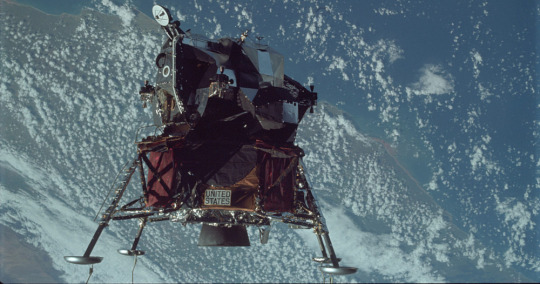
In March of 1969 the CM Gumdrop (Dave Scott thought it looked like a piece of candy when it arrived at the Cape wrapped in cellophane) and LM Spider (well, just look at it!) were launched and tested thoroughly in Earth orbit. When Jim and Rusty flew off in Spider they became the first men to fly a spacecraft which could not land if things went wrong (weight was such an issue that the cabin walls were made of layers so thin that if you dropped a screwdriver it would puncture them, and of course it had no heat shield to get through Earth's atmosphere).
The crew put Spider through its paces; firing the descent engine several times, testing its ability to maneuver with the thrusters, and firing the ascent engine to get back to Dave in Gumdrop. Rusty also did a modified spacewalk to test the lunar EVA suit (sadly, he was spacesick at the beginning of the mission and as a result, never got to fly again).
After retiring from active flight status, Jim served as NASA’s Spacecraft Program Manager for a few years and retired from the Air Force in 1972 with the rank of Brigadier General; he also earned a buttload of Flying Medals, Distinguished Service Medals, and other honors throughout the course of his life.

Jim, Dave, and Rusty reunited in 2019 for the flight's 50th anniversary. With Jim’s passing, the Apollo 8 crew is the last Apollo crew still intact.
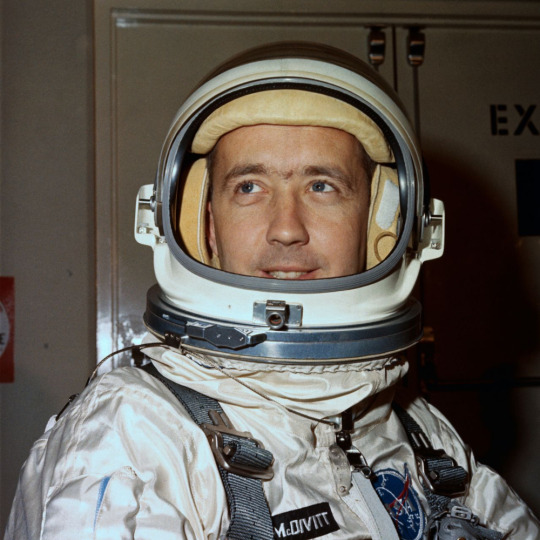
Ad Astra, Jim: June 10 1929 - October 14, 2022
1 note
·
View note
Text
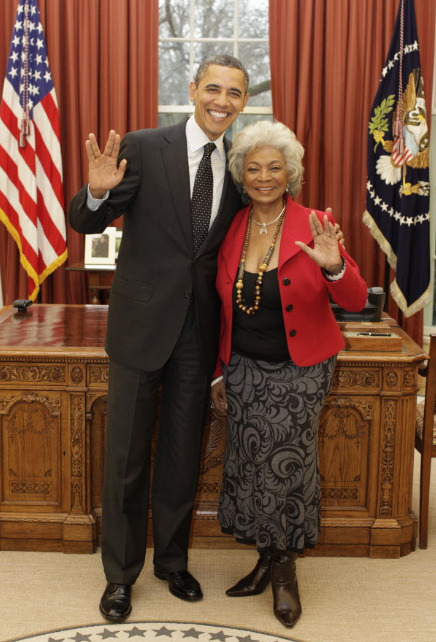
Oval Office Vulcan salute - President Obama and Nichelle Nichols. Photo by Pete Souza. Obama Library, NARA ID 200283671.
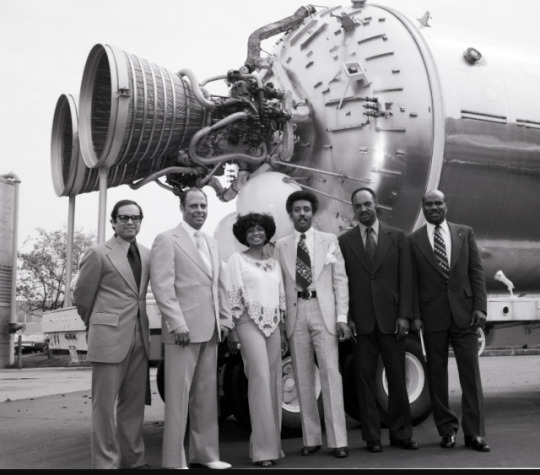
Nichelle Nichols at NASA's Glenn Research Center, 4/20/1977, NARA ID 17468123.
#RIP Nichelle Nichols Star Trek's Lt. Uhura goes to the final frontier By Miriam Kleiman, Public Affairs
youtube
Nichelle Nichols - NASA Recruitment Film 1977.
“Last night, my mother, Nichelle Nichols, succumbed to natural causes and passed away. Her light however, like the ancient galaxies now being seen for the first time, will remain for us and future generations to enjoy, learn from, and draw inspiration. Hers was a life well lived and as such a model for us all." Statement from Nichols’ son, Kyle Johnson
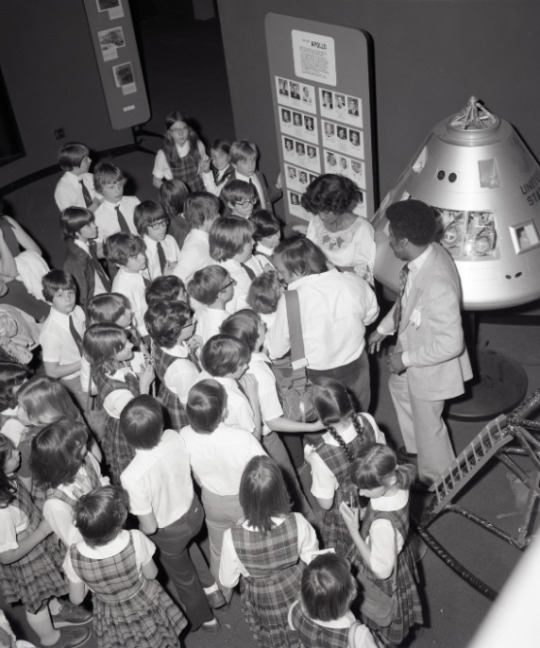
Nichols with adoring fans at NASA's Glenn Research Center, 4/20/1977, NARA ID 17468124 .
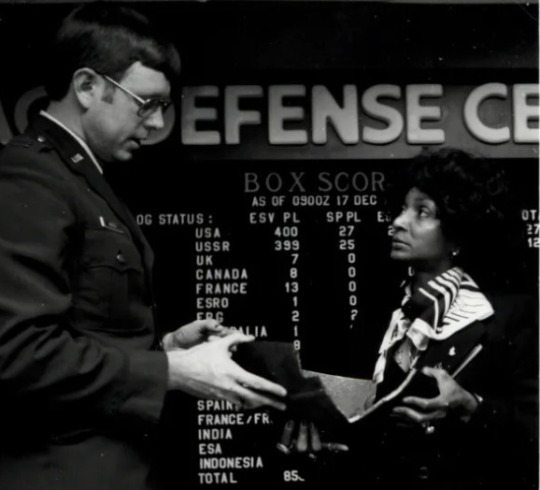
Nichelle Nichols holds a piece of a satellite presented by Capt. David Martin at NORAD, 1/6/1977, RG 342. Online here.
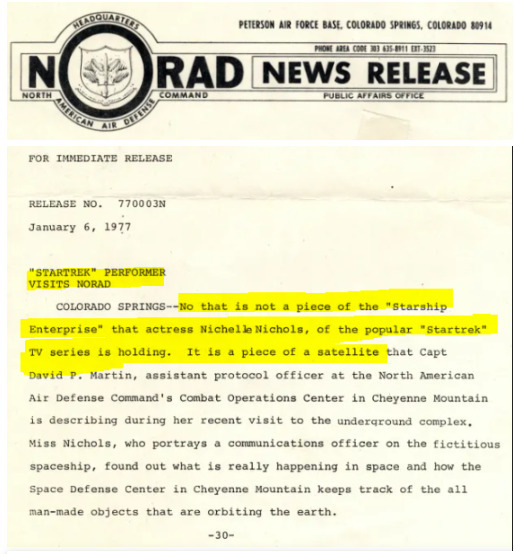
NORAD press release 1/6/1977, RG 342, Records of US Air Force, online.
More online:
In Memoriam: Nichelle Nichols (1932-2022), National Archives News.
To Boldly Go Where No (Wo)Man Has Gone Before… by Archives Specialist Netisha Currie.
Nichelle Nichols Helped NASA Break Boundaries on Earth and in Space, NASA.gov
Mae Carol Jemison- The First African American Woman in Space, Pieces of History by Dena Lombardo.
Space Exploration - NASA Records at the National Archives
#nasa#stem#blm#representation matters#star trek#i love star trek#women in stem#black women in stem#rip nichelle#rip nichelle nichols#obama#obama library#rip#black women rock#black history#african american history#rediscoveringblackhistory#norad#greatwomen#nichelle nichols
3K notes
·
View notes

